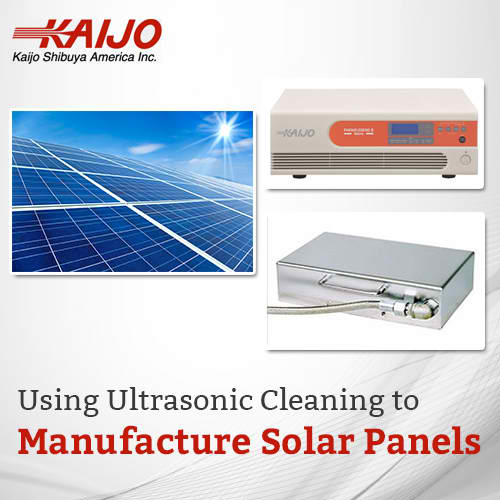Using Ultrasonic Cleaning to Manufacture Solar Panels
December 9, 2019
 Solar Panels are made from silicon wafers which have gone through an etching and cleaning process and then mounted behind glass sheets. Several of the intermediate steps require cleaning of the silicon wafers and glass sheets. Ultrasonic cleaning systems effectively remove contaminants and residues quickly and completely while leaving the underlying silicon wafers or glass sheets unaffected. An additional benefit is that ultrasonic cleaning works without the use of harsh chemicals, using a bath of plain water or water with a mild detergent.
Solar Panels are made from silicon wafers which have gone through an etching and cleaning process and then mounted behind glass sheets. Several of the intermediate steps require cleaning of the silicon wafers and glass sheets. Ultrasonic cleaning systems effectively remove contaminants and residues quickly and completely while leaving the underlying silicon wafers or glass sheets unaffected. An additional benefit is that ultrasonic cleaning works without the use of harsh chemicals, using a bath of plain water or water with a mild detergent.
Cleaning Silicon Wafers
Making solar cells from silicon wafers involves fabrication steps such as etching the silicon, doping the wafers to create positive and negative charge areas and the depositing of conducting and non-reflecting films. During these manufacturing steps, the wafers are exposed to chemicals and parts of the wafer may be masked to shape the deposited film. In each case, the wafers have to be cleaned thoroughly before the next production step can take place.
When the wafers are treated with chemicals, they are rinsed at the end of the process steps but traces of chemicals may remain. Such chemical traces can shorten the life span of the solar cells and reduce their efficiency while also impacting the next steps. Ultrasonic cleaning removes chemical contamination from the surfaces of the wafers and leaves them ready for subsequent fabrication.
If wafers are masked to produce conductive paths on the solar cells, the masks have to be removed once the conductive film is deposited. Ultrasonic cleaning can completely remove the masking substance without damaging the thin and delicate conducting paths that have been deposited. Such complete cleaning is essential for the proper functioning of the solar cells.
After all the process steps are finished and the solar cells are ready to be assembled into solar panels, they must be cleaned one last time to ensure they don’t introduce impurities into the sealed solar panel casing. The solar cells are delicate and have to be cleaned gently. By using higher ultrasonic frequencies, ultrasonic cleaning systems can deliver cleaning action that is as gentle as desired while still removing all traces of contamination.
Cleaning the Glass Sheets
Solar cells have to be assembled into larger units to create solar panels that can produce substantial amounts of electrical power. Typically solar cells are mounted into assemblies made up of grids such as three by four or four by six cells. The cells are mounted on a backing, covered with a sheet of glass and sealed. While the solar cells have been cleaned to ensure they don’t introduce contaminants into the sealed assembly, the glass sheets may have residues of solvents, oils or chemicals on their surfaces.
Because ultrasonic cleaners can work within a bath of plain water, the cleaning method is ideal for making sure no chemical residues are left on the glass surfaces. Contaminants on the glass can hurt solar panel functions and break the seals, allowing moisture to penetrate the panel. Moisture can corrode conductors and its condensation can block some of the sunlight that produces solar panel power. Glass cleaned ultrasonically helps maintain high product quality and keeps the solar panels functioning for extended periods.
The Benefits of Using Ultrasonic Cleaning for Solar Panel Manufacturing
Traditional silicon wafer and glass cleaning methods require special rinsing to remove traces of contaminants and they work more slowly than ultrasonic cleaning. The cost of cleaning chemicals along with costs for their storage and disposal can make ultrasonic cleaning with its lower operating costs an attractive solution. In addition to saving money, the quick and complete cleaning action of ultrasonic cleaning systems makes them ideally suited for solar panel manufacturing. Ultrasonic cleaner manufacturer Kaijo offers free consulting to ensure customers get the cleaning performance that meets their requirements.





